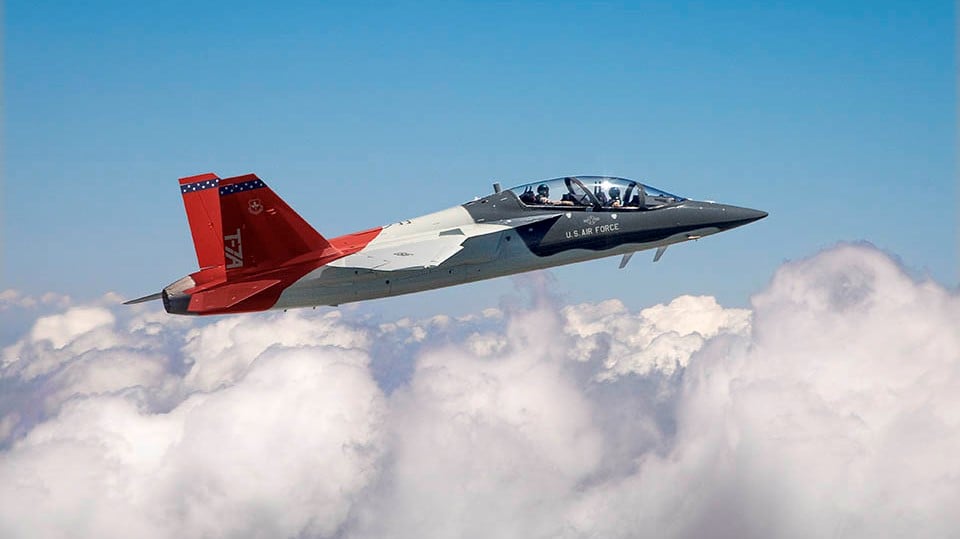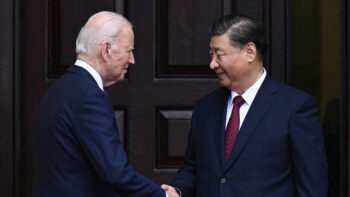
A T-7 trainer, featured in promotional material from Boeing. (Boeing)
WASHINGTON — The Air Force now expects an over two-year delay on entering production of its T-7A Red Hawk training jet, thanks to a series of design issues discovered during prototyping — including issues with the plane’s emergency escape system.
According to statements from the service and the aircraft’s manufacturer Boeing, the aircraft’s production phase will begin in February 2025 with delivery scheduled to start in December 2025 — at least two years later than originally planned. Initial operational capability has been pushed to spring 2027 as a result of the delays.
Developed using digital design tools that Air Force and Boeing officials say helped accelerate its timeline, the Red Hawk, built by a joint team of Boeing and Saab, recently saw its schedule slip after problems with the aircraft’s emergency escape system and others emerged during testing, prompting the schedule re-baseline. Air and Space Forces Magazine first reported the new milestone C date.
In a statement, the Air Force said that by June of 2022, the service and Boeing had decided to re-baseline the expected target dates. In the process, the service looked at all the issues encountered so far by the T-7, including “in ground, pre-flight testing and hardware qualification challenges; contractor inability to rapidly correct deficiencies; subcontractor initial design delays; three aerodynamic instability discoveries; escape system qualification delays; and supplier critical parts shortages,” an Air Force spokesperson said in a statement.
“Boeing and the U.S. Air Force recently undertook a joint effort to re-baseline the schedule, arriving at a new Milestone-C date of no later than February 2025,” Boeing said in a statement. “Boeing and the USAF are partnered on a path forward regarding the escape system and qualifying the system to ensure aircrew will have the safest egress system in any trainer.”
The biggest concern appears to be the functionality of the ejection system for pilots.
According to a report in Air Force Times, worrying testing results showed a “high risk for concussions, unsafe acceleration when a parachute opens, and the possibility that a pilot’s helmet visor could fly off at high speeds,” in the event one had to punch out. A key issue is making an escape system that works for more pilots, which Defense News noted must reflect a 2020 Air Force mandate to accommodate pilots beyond decades-old standards largely tailored to men.
The Government Accountability Office last year identified the emergency escape system as a top risk to the program’s schedule in its annual weapon systems assessment, stating as well that previous milestone delays were “primarily due to Boeing’s continued underestimation of the scope of the work and resources needed to accomplish it.”
Boeing, which bid aggressively to win the Red Hawk contract in 2018, has paid the price of its fixed-cost structure, which a company spokesperson said has amounted to approximately $1.1 billion in charges. The Air Force expects to procure 351 aircraft to replace its fleet of 422 T-38s, with options to buy more.
Though the program first aimed to start production this year, officials ultimately decided 2024 would be out of reach as well, deferring funds to start building the aircraft to fiscal 2025, according to Air Force FY24 budget documents [PDF]. Boeing is currently flying two production-relevant jets with its own test pilots; the Air Force will use the first three engineering and manufacturing development jets for military flight tests at Edwards Air Force Base, Calif., that are slated to begin in September, according to an Air Force spokesperson.
After the program successfully executed a sled test — simulated crashes of the pilot’s ejection seat — Andrew Hunter, the Air Force’s acquisition czar, told lawmakers recently that the aircraft is on path for military flight release, paving the way for it to take to the skies with government pilots later this year.
“We did have a substantial achievement in February of getting through performing a sled test, dealing with some of the issues with the escape system that we were hung up on. That will allow us to get the military flight release and begin the developmental tests, so we are now moving forward from areas where the program had gotten stalled,” he said before the House Armed Services tactical air and land subcommittee on March 29.
In a statement to Breaking Defense, Hunter said the program is set “to conduct the first taxi test within the next several weeks.”
The setback may mean the Air Force could be forced to keep T-38 Talons — an airframe that has been testing pilots’ mettle since the Vietnam War — in its inventory longer than it wants to. Recapitalizing the aging jet has been a priority for some lawmakers worried that pilots could be at risk if they have to fly the aircraft for much longer.
“The T-38 has killed too many people,” Rep. Mike Garcia, R-Calif., said during a hearing of the House Appropriations defense subcommittee in March, referring to previous deadly accidents with the Talon.
“Whatever we can do to accelerate the production of the T-7 to replace the T-38 is absolutely critical to our nations’ future, especially the Air Force pilot force,” he said.






















